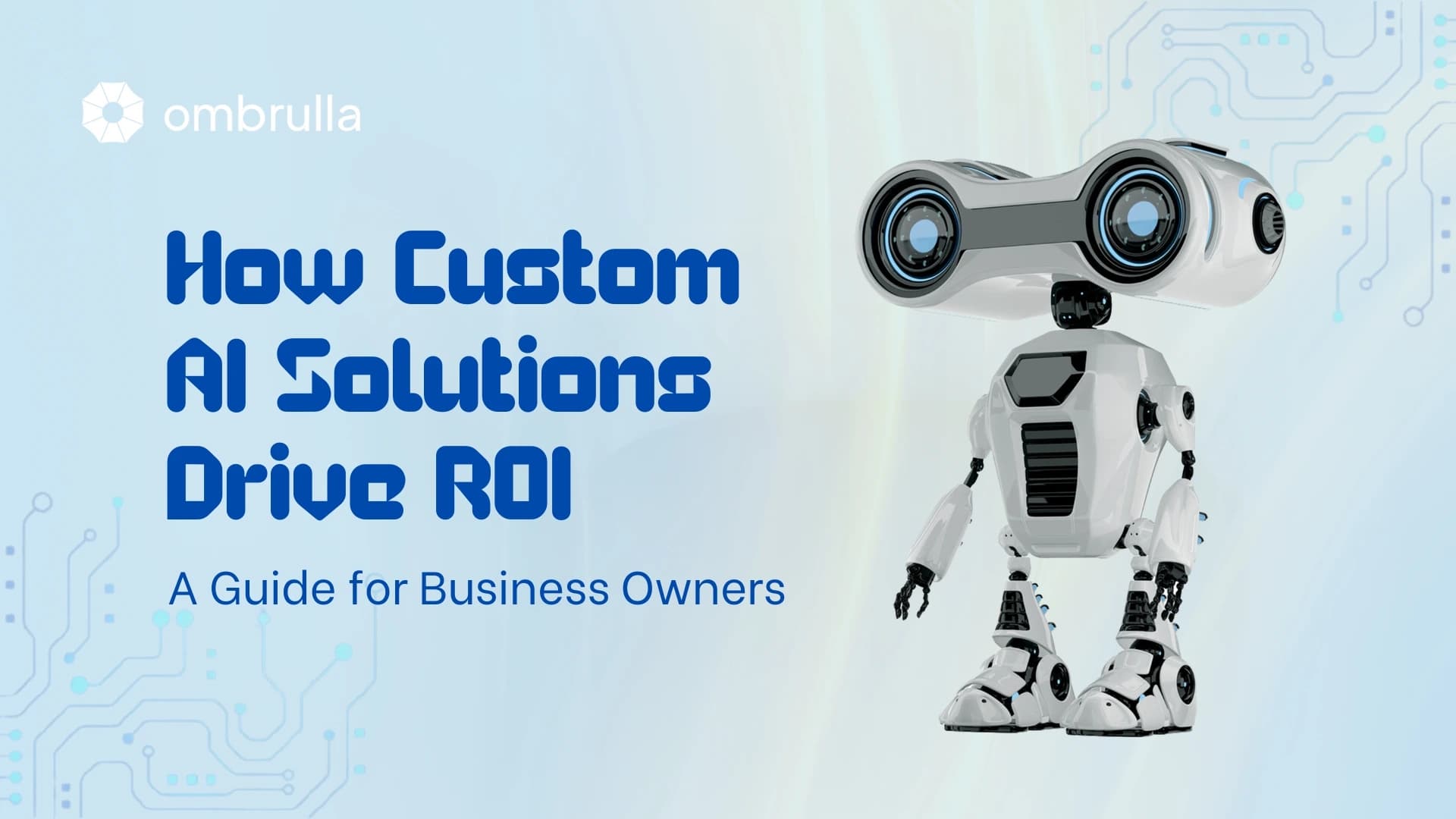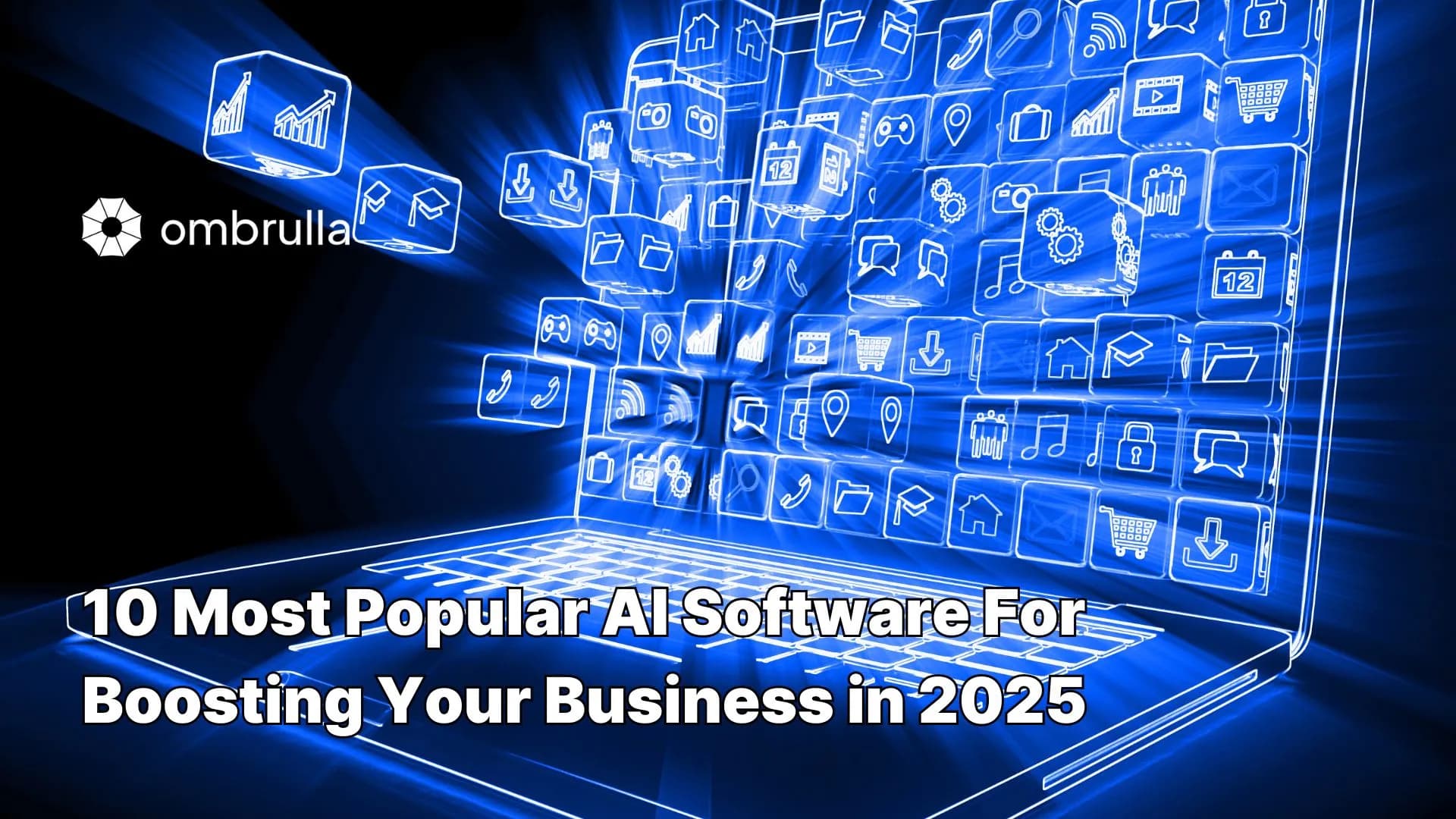Introduction
Artificial intelligence isn’t just a buzzword anymore it’s a decisive edge for businesses that want to stay ahead. But for owners and senior leaders, the real question is whether a custom AI solution will truly deliver ROI or simply drain resources. You don’t want to get lost in jargon and hype; you want clear, practical guidance. This guide will show you exactly what custom AI solutions are, how they work, and when it makes sense to invest in them. You’ll see practical roadmaps, real industry examples, and learn how to measure ROI in the real world. If you’re ready to transform operations and sharpen your competitive advantage, this playbook is for you.
What Are Custom AI Solutions?
Custom AI solutions leverage machine learning, computer vision, and natural language processing to address your business’s unique operational challenges using your actual data, processes, and environments.
Unlike generic AI tools, custom AI solutions are deeply integrated into your workflows, eliminating manual bottlenecks and generating insights that directly improve your KPIs and operational efficiency.
Here’s how this looks across industries:
Examples:
Oil and Gas Industry:
A leading offshore operator uses AI-driven predictive maintenance on critical equipment, analyzing sensor and maintenance data to forecast failures, reducing unplanned shutdowns by up to 20% and saving significant operational costs.
Manufacturing:
An advanced electronics producer uses computer vision for real-time defect detection on production lines, reducing manual inspection time by 30% while improving quality consistency and reducing scrap.
Automobile Manufacturing:
An automotive plant employs custom AI for predictive maintenance on robotic welding and assembly lines, using vibration and thermal data to anticipate component failures and minimize unplanned downtime.
Textile Industry:
A large textile manufacturer has adopted AI-enabled quality inspection to detect weaving defects and color inconsistencies during production, reducing manual checks and wastage while ensuring consistent fabric quality.
By addressing high-impact, industry-specific challenges using your unique data, custom AI solutions deliver precision, relevance, and measurable operational improvements, helping your business enhance productivity, reduce costs, and stay ahead of competitors in a data-driven future.
Why Business Owners Should Care
1. Solve Problems Generic Tools Can’t
Your workflows are unique. Off-the-shelf tools cannot align with your operations or utilize your proprietary data effectively. Custom AI helps:
- •Eliminate repetitive manual tasks draining teams.
- •Enable precise forecasting tied to your data.
- •Resolve inefficiencies deeply rooted in your processes.
2. Gain Competitive Edge
AI is not optional in modern operations. Custom AI empowers:
- •Faster, confident decisions.
- •Reduced operating costs.
- •Improved customer experiences.
3. Retain Flexibility and Control
Your business shouldn’t adjust to a tool. Your tools should adapt to your business. Custom AI evolves with your goals, ensuring you remain in control.
When Is It Worth Building a Custom AI Solution
A custom AI solution is worth your investment if:
- •You have clean, structured operational data.
- •Your business faces repetitive, data-driven challenges.
- •You’re ready to adjust workflows to maximize AI outcomes.
- •You can define clear ROI metrics.
If your data is scattered or operations are unstructured, prioritize data infrastructure before moving to AI.
Implementation Roadmap: From Idea to Impacts
Implementing a custom AI solution requires more than just good intentions; it demands a structured, disciplined approach to ensure success. Many AI initiatives fail not because of the technology but due to unclear steps and poor execution. A clear roadmap helps business owners and senior leaders move from idea to measurable impact efficiently. By breaking down the process into focused, actionable stages, you can manage risks while ensuring alignment with your business goals. Here is a step-by-step roadmap to transform your AI investment into tangible operational value.
A disciplined approach ensures your investment pays off:
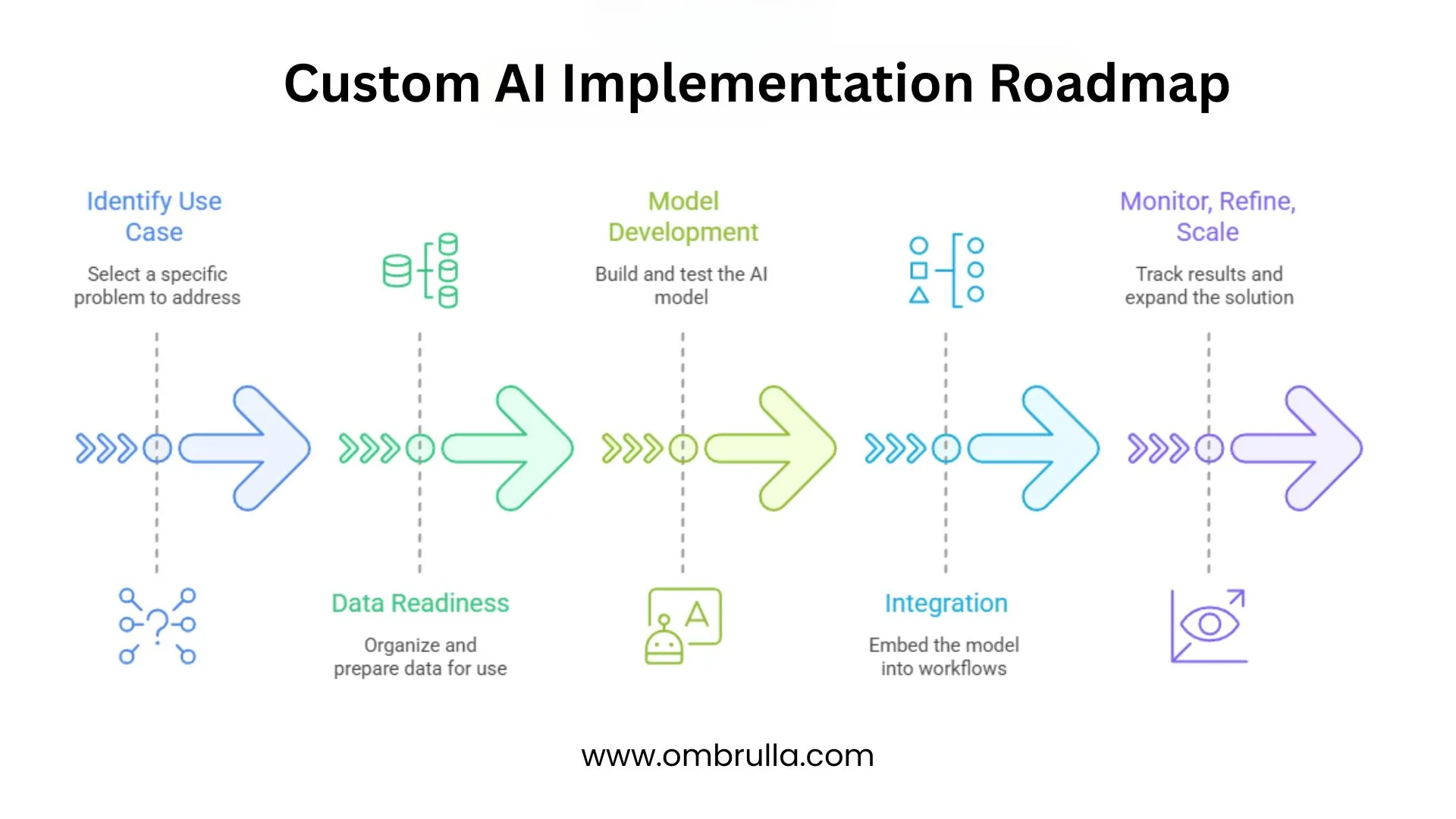
Step 1: Identify a High-Impact Use Case
Pick a focused problem. Example: Predicting machine failures to reduce unplanned downtime.
Step 2: Data Readiness
Organize your data. Work with your operations and tech teams to ensure it is accurate and labeled.
Step 3: Model Development
Your AI team or partner builds and tests the model using your data, ensuring relevance and accuracy.
Step 4: Integration
Embed the model into your workflow—dashboards, ERP, APIs—where decisions happen.
Step 5: Monitor, Refine, Scale
Track results, retrain with new data, and expand the solution across operations after proving ROI.
Industry Use Cases: What’s Possible
AI is transforming industries with tailored solutions that enhance efficiency, accuracy, and decision-making. From predictive maintenance in manufacturing to fraud detection in finance, organizations are leveraging AI to address unique challenges. This overview highlights how custom AI applications are driving innovation across manufacturing, retail, finance, and healthcare.
1. Manufacturing
• Predictive maintenance to reduce downtime.
• Computer vision for defect detection.
• Machine energy optimization.
2. Retail
• Store-specific demand forecasting.
• Dynamic pricing optimization.
• In-store customer flow analysis.
3. Finance
• Custom fraud detection models.
• Credit risk scoring.
• Customer churn prediction.
4. Healthcare
• No-show predictions to optimize scheduling.
• Imaging-based diagnostics.
• Personalized treatment recommendations.
Pitfalls to Avoid in Custom AI Solutions
When building custom AI solutions, success isn't just about the technology it’s also about the strategy behind it. Many initiatives fail due to avoidable missteps that can derail progress and ROI. Here are four key pitfalls every business should watch out for.
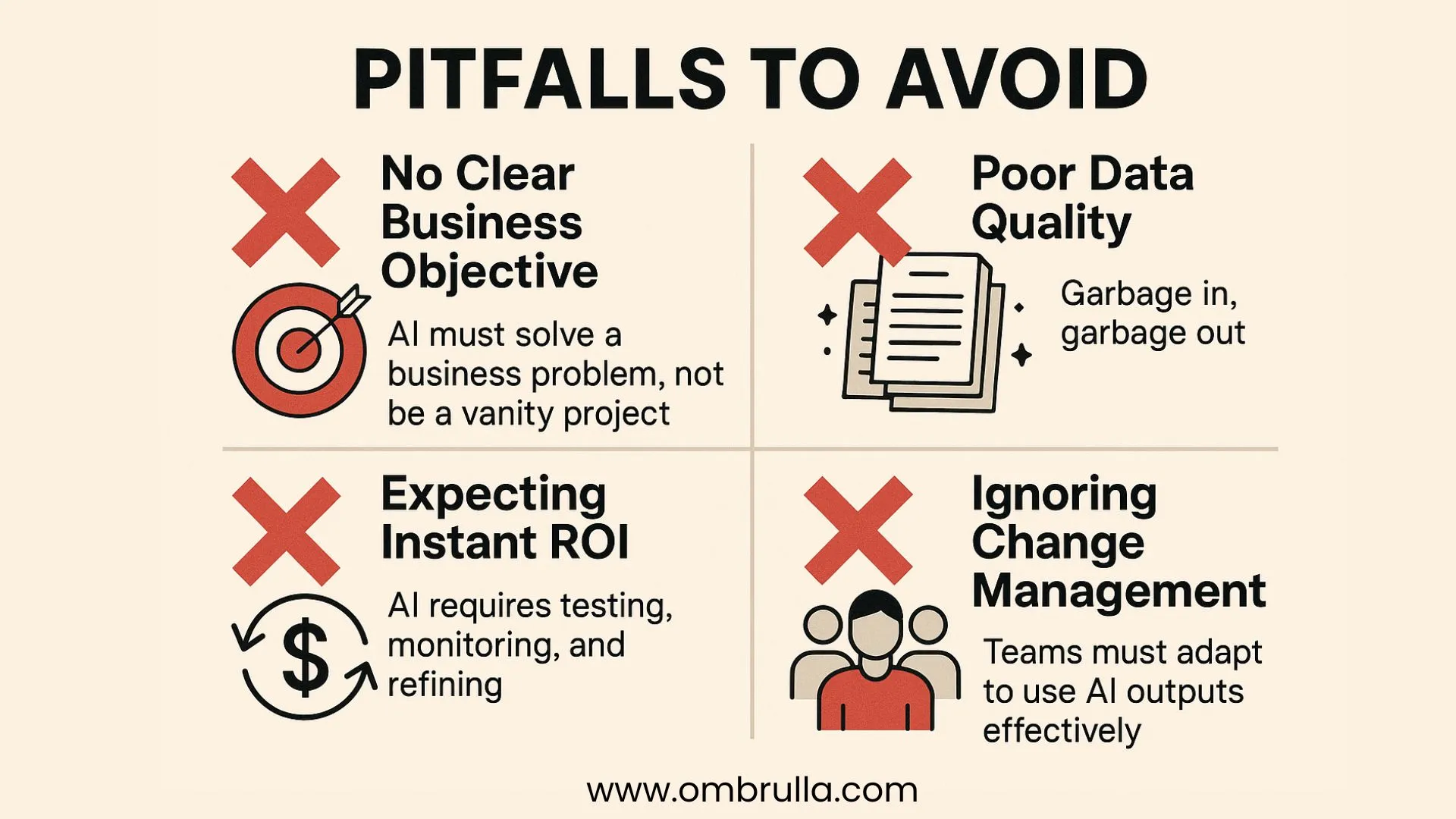
How to Measure ROI Practically
One of the biggest concerns for business owners before investing in custom AI is:
“How do we know if it’s working and worth it?”
Measuring ROI for AI projects requires clear, tangible metrics tied directly to operational and financial outcomes. Here is how to practically evaluate the ROI of your custom AI initiatives:
1. Time Savings (Manual Hours Reduced)
AI automates repetitive, manual tasks, freeing your team to focus on higher-value work.
Example Metrics:
- Manual form processing leading to delays and errors.
- High inspection hours and manual effort in data processing tasks.
- Operational inefficiencies in planning and reporting.
Market Insight:
According to McKinsey, AI can automate up to 60-70% of tasks in data processing-heavy industries, leading to 20-30% productivity improvement in functions like supply chain, quality inspection, and customer operations.
Action Step:
Track hours spent on manual processes before and after AI implementation, and calculate the dollar value using average employee cost per hour.
2. Cost Reduction (Waste, Downtime, Rework)
AI reduces operational inefficiencies that drain budgets, including:
Example Metrics:
- Manual form processing leading to delays and errors.
- High inspection hours and manual effort in data processing tasks.
- Operational inefficiencies in planning and reporting.
Market Insight:
Manufacturers adopting AI-driven predictive maintenance see 20-40% reduction in maintenance costs and up to 50% reduction in unplanned downtime (Deloitte, McKinsey).
Action Step:
Calculate the cost of waste, downtime, and rework pre-AI and compare it with post-AI periods to quantify the reduction.
3. Revenue Uplift (Forecasting, Pricing, Upselling)
AI empowers smarter forecasting and pricing strategies that can directly improve top-line revenue, such as:
Example Metrics:
- Manual form processing leading to delays and errors.
- High inspection hours and manual effort in data processing tasks.
- Operational inefficiencies in planning and reporting.
Market Insight:
Boston Consulting Group reports AI can drive up to 10% revenue growth in retail through improved personalization and forecasting. In manufacturing, better demand forecasting can reduce inventory costs by 20-50%, indirectly boosting cash flow and customer service levels.
Action Step:
Monitor revenue trends in the specific business area influenced by AI, and attribute increases to forecast accuracy, pricing adjustments, or improved service enabled by AI insights.
4. Accuracy Gains (Forecasting, Defect Detection, Risk Assessment)
AI models consistently outperform human guesswork and traditional rules-based systems by identifying patterns in large data sets, leading to:
Example Metrics:
- Manual form processing leading to delays and errors.
- High inspection hours and manual effort in data processing tasks.
- Operational inefficiencies in planning and reporting.
Market Insight:
AI models in defect detection can achieve accuracy rates of 95-99%, compared to 70-85% in manual inspections (NASSCOM, Capgemini). In financial services, AI fraud detection reduces false positives by up to 90% while improving fraud capture rates.
Action Step:
Track the accuracy of your existing processes (baseline) versus AI-driven outputs, quantifying the improvements using measurable KPIs (e.g., reduction in defect escape rate, forecasting error rates).
Prove It Works: Why Custom AI Needs Clear Benchmarks
Custom AI solutions go beyond off-the-shelf tools they are built to solve your business problems. From reducing errors to improving productivity, tailored AI delivers real value.
But here’s the key: you can’t manage what you don’t measure.
That’s why benchmarks matter.
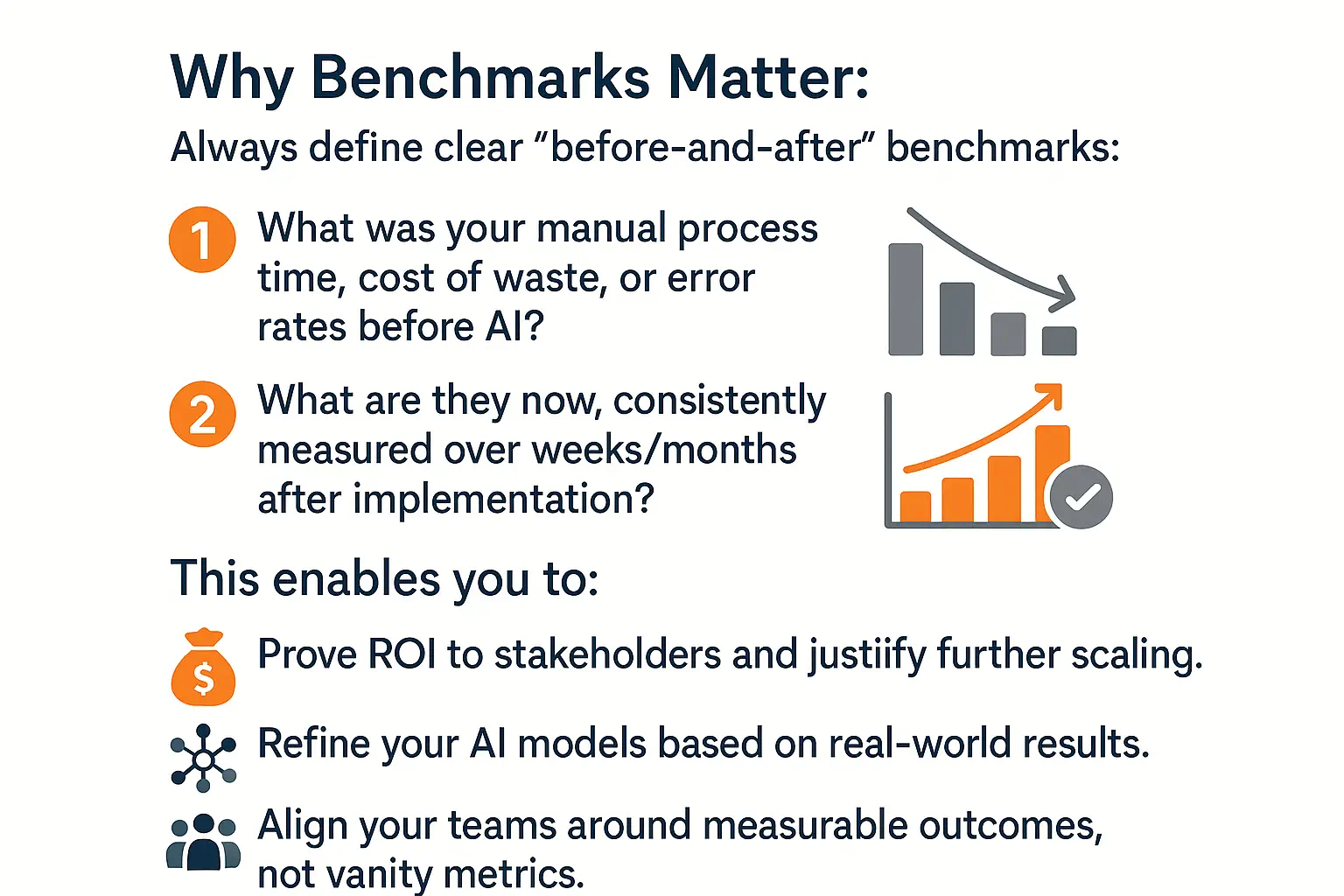
Putting It Together: A Simple ROI Formula
For a practical calculation:

Where:
- •Financial Benefits = Time savings (valued), cost reductions, revenue gains.
- •AI Costs = Development, deployment, training, and maintenance costs.
Example:
If your AI project saves $500,000 annually in downtime and rework, and costs $200,000 annually to maintain:

A clear signal for business owners to continue or scale the initiative.
Summary Table for Decision-Makers
Summary Table for Decision-Makers highlights the measurable impact of AI across key business metrics. From time and cost savings to revenue uplift and accuracy improvements, these benchmarks help decision-makers evaluate performance potential. Use them to align AI initiatives with strategic goals and ROI expectations.
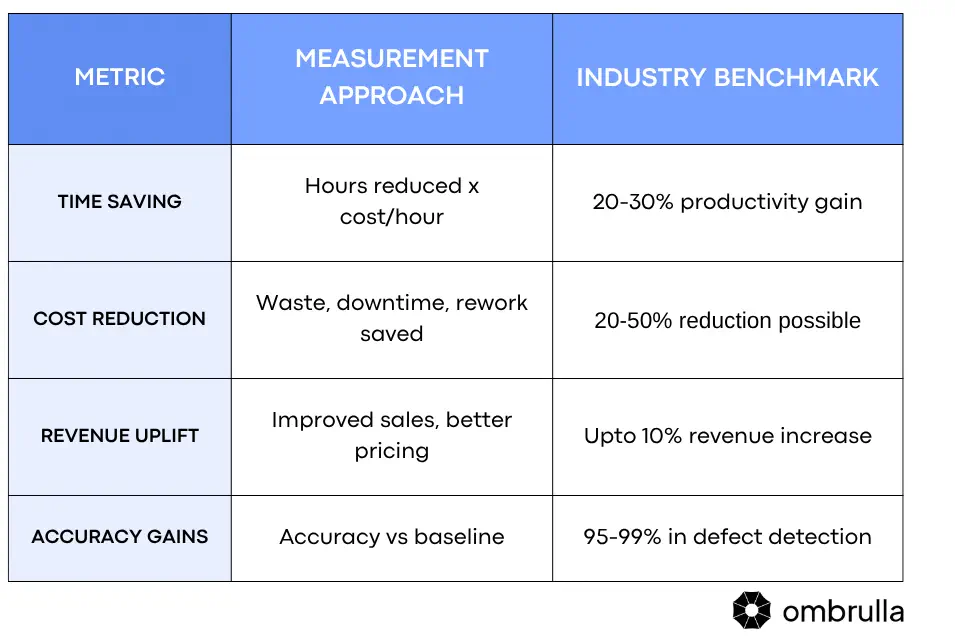
AI ROI measurement is not about “gut feeling.” It’s about structured, measurable financial and operational improvements aligned with your business goals.
- • Identify the exact metrics relevant to your use case.
- • Track them rigorously before and after implementation.
- •Use these insights to decide whether to expand your AI initiatives.
This practical approach will give you clarity, confidence, and control, enabling you to move from “AI curiosity” to “AI as a profit-driving core capability.”
Custom AI vs. Off-the-Shelf AI: A Clear Comparison
Choosing between Custom AI and Off-the-Shelf AI depends on your business goals, data availability, and long-term vision. Each option offers distinct advantages in adaptability, cost, deployment speed, and scalability. The comparison below helps clarify which solution best fits your operational needs.

- • Choose Custom AI if your challenges are unique, and you want a competitive edge.
- •Choose Off-the-Shelf AI for general task automation where deep integration isn’t needed.
What a Successful Custom AI Project Looks Like
A successful custom AI project follows a clear, goal-driven approach from problem definition to full-scale deployment. Each phase from data utilization to pilot testing and integration plays a vital role in driving measurable outcomes. The example below illustrates how AI can effectively reduce downtime and optimize operations.
Problem:
Reduce unplanned production line downtime by 20%.
Data:
Intel and Foxconn achieve 95% defect detection vs 70–80% by humans.
Pilot:
Model developed on one production line.
Integration:
Alerts linked to your dashboards.
Measurement:
Downtime and cost savings tracked.
Scaling:
Extended to other lines with continuous improvements.
Key Questions Before You Start
Before starting any AI project, asking the right questions is key to ensuring success. From defining the core problem to assigning clear ownership, each step lays the foundation for effective implementation. The checklist below outlines five essential considerations for a smooth and impactful AI rollout.

Final Takeaway: Custom AI Is a Practical Advantage
Custom AI is not a magic wand, but for business owners and senior management ready to lead, it offers:
- •Faster, confident decision-making.
- •Leaner, more cost-efficient operations.
- •Future-proof competitive strength.
The winners of the next five years will be businesses that replace guesswork with precision, and manual effort with intelligence. Start with a single high-impact use case. Measure results. Scale once proven. That’s how custom AI transforms from hype into a practical engine for business growth.




